Ginger Dehlinger's Blog, page 9
January 10, 2017
Money in the Old West--Part II
(see previous blog post for introduction and more information)
During Alaska’s gold rush, miners put specified weights of gold dust in squares of writing paper, sealed them, and then labeled each packet with the value of the gold inside. (approximately $16 per ounce at the time) These small packets of gold dust were used throughout the state as money, most commonly in one or two-dollar denominations. Some of the packets were still being exchanged after 1899 when the Klondike gold rush ended.
Real gold and real silver coins also circulated, some issued by the US government, others by the states. The “slug,” a $50 gold piece, was used mainly in California, but also circulated in other parts of the country. The percentage of precious metal the coins contained, as well as their value, fluctuated over the years. During the California gold rush, for instance, miners stopped digging for silver and flocked to the gold fields, resulting in a brief period where silver was more valuable than gold. When that happened, people began hoarding silver coins or melting them down since they were worth more as metal than currency.
Coins were also hoarded by professional gamblers. They were less messy than gold dust, easier to verify as the real deal, and they didn’t need to be weighed. If an ordinary cowboy wanted to join a game of cards, and he didn’t have coins, he might bet personal items, such as clothing, ammunition, or his saddle. In Never Done, Vincent teaches Clara how to play poker, and the young couple uses dried beans to make their wagers. Clara mastered the game quickly, winning beans about as often as she lost them. She soon grew tired of moving small piles of beans back and forth across the table, and one day, after Vincent won with a full house higher than hers, she gave the poker stakes a rinse and cooked them for supper.
Due to the lack of coins in circulation, it became almost impossible in the Old West to make change, which resulted in the going rate of a dollar for many items or services regardless of their size or value. My heroine Clara ends up managing a hotel in Ophir Loop, Colorado where the sign near the entrance reads, “Good Beds, $1.00 a Night.” When winter rolls around, the hotel is full to bursting with miners looking for a warm place to stay. Some men had to double up. Although they shared both room and bed, Clara charged each man a dollar per night for the room, a dollar apiece for the food, and nobody argued.
Most frontier communities were small. The townspeople knew each other well and were familiar with the farmers and ranchers who came into town for supplies or entertainment. Rather than charging for every item an individual or family bought, the owner of the general store usually kept track of them in a ledger, asking the accounts be settled by the end of each month. Sometimes the settlement was in the form of commodities or labor.
Accepting paper currency was a risk for many years. Issued by banks or state governments, it could be redeemed for gold or silver coin, but only at the bank that issued it, and many of those “wildcat banks” didn’t have the coin to back up the bills they printed. Paper became a more acceptable medium of exchange after 1863 when National notes became the standard. Counterfeiting, however, became an issue, and still remains a headache, even with modern "fool-proof" designs.
In today’s nearly cashless society, all of the mediums and methods of exchange used in the Old West seem crude and complicated. To me, however, the sociability and trust implicit in having an account at the general store is preferable to the plastic, PayPal, or e-bill pay I use to make sterile, faceless transactions.
During Alaska’s gold rush, miners put specified weights of gold dust in squares of writing paper, sealed them, and then labeled each packet with the value of the gold inside. (approximately $16 per ounce at the time) These small packets of gold dust were used throughout the state as money, most commonly in one or two-dollar denominations. Some of the packets were still being exchanged after 1899 when the Klondike gold rush ended.
Real gold and real silver coins also circulated, some issued by the US government, others by the states. The “slug,” a $50 gold piece, was used mainly in California, but also circulated in other parts of the country. The percentage of precious metal the coins contained, as well as their value, fluctuated over the years. During the California gold rush, for instance, miners stopped digging for silver and flocked to the gold fields, resulting in a brief period where silver was more valuable than gold. When that happened, people began hoarding silver coins or melting them down since they were worth more as metal than currency.
Coins were also hoarded by professional gamblers. They were less messy than gold dust, easier to verify as the real deal, and they didn’t need to be weighed. If an ordinary cowboy wanted to join a game of cards, and he didn’t have coins, he might bet personal items, such as clothing, ammunition, or his saddle. In Never Done, Vincent teaches Clara how to play poker, and the young couple uses dried beans to make their wagers. Clara mastered the game quickly, winning beans about as often as she lost them. She soon grew tired of moving small piles of beans back and forth across the table, and one day, after Vincent won with a full house higher than hers, she gave the poker stakes a rinse and cooked them for supper.
Due to the lack of coins in circulation, it became almost impossible in the Old West to make change, which resulted in the going rate of a dollar for many items or services regardless of their size or value. My heroine Clara ends up managing a hotel in Ophir Loop, Colorado where the sign near the entrance reads, “Good Beds, $1.00 a Night.” When winter rolls around, the hotel is full to bursting with miners looking for a warm place to stay. Some men had to double up. Although they shared both room and bed, Clara charged each man a dollar per night for the room, a dollar apiece for the food, and nobody argued.
Most frontier communities were small. The townspeople knew each other well and were familiar with the farmers and ranchers who came into town for supplies or entertainment. Rather than charging for every item an individual or family bought, the owner of the general store usually kept track of them in a ledger, asking the accounts be settled by the end of each month. Sometimes the settlement was in the form of commodities or labor.
Accepting paper currency was a risk for many years. Issued by banks or state governments, it could be redeemed for gold or silver coin, but only at the bank that issued it, and many of those “wildcat banks” didn’t have the coin to back up the bills they printed. Paper became a more acceptable medium of exchange after 1863 when National notes became the standard. Counterfeiting, however, became an issue, and still remains a headache, even with modern "fool-proof" designs.
In today’s nearly cashless society, all of the mediums and methods of exchange used in the Old West seem crude and complicated. To me, however, the sociability and trust implicit in having an account at the general store is preferable to the plastic, PayPal, or e-bill pay I use to make sterile, faceless transactions.
Published on January 10, 2017 10:11
December 7, 2016
Money in the Old West--Part One
“It was not by gold, or by silver, but by labour that all wealth of the world was originally purchased.” Adam Smith
While doing research for Never Done, I learned much about the nature of money in the Old West or what substituted for it. I incorporated some of what I learned in my novel if it fit the story’s action or theme. For example, in part IV, “To Market, To Market,” I write how the main character, Clara, and her husband exchange food with the Stuart’s, their closest neighbors. In autumn, the trees in the Stuart family’s orchard were heavy with fruit. Albert shared the beef he butchered with his men, and Vincent traded some of it to the Stuart’s for apples. Barter was common in sparsely-settled parts of the West, whereas bank accounts were rare. Self-employed farmers exchanged what they grew or raised for canned goods, seed, building materials, or clothing. The milk and eggs they produced were the two items most prized by people living in towns. Wage-earning townspeople were either paid in cash or with chits and coupons redeemable only at the company store. The storekeepers kept track of a household or customer's monthly purchases, and then settled accounts on payday.
Long before the West was won, trappers swapped beaver and fox furs for tobacco, hunting gear, alcohol, and food. Native Americans traded hides and rugs for beads, cooking utensils, and horses. In “Make Do and Mend,” part III of Never Done, Vincent sells the wolf hides he cures over the winter and uses the money to buy a Singer sewing machine for Clara. Cowboys were usually paid in cash. When they ran out of cash, they often paid for a well-earned drink at the saloon with a .45 caliber bullet. Back then a bullet cost about the same as a glass of whiskey, hence the expression “shot” of whiskey or other hard liquor. Miners buying a drink at the same saloon might pay with a pinch of gold dust rather than plunking a bullet or coin on the bar.
Gold dust or gold nuggets were acceptable almost everywhere as currency. Every store kept a gold scale on the counter to weigh it; although with questionable accuracy. Saloons didn’t use scales, and many bartenders became rich skimming dust off the saloon’s earnings. Sometimes they carried it home under their fingernails. Other times a bartender would rub grease in his hair before his shift, and then casually run his fingers through it after he was paid. Later he would wash the gold out of his hair, giving himself a nice bonus. (to be concluded next month)
While doing research for Never Done, I learned much about the nature of money in the Old West or what substituted for it. I incorporated some of what I learned in my novel if it fit the story’s action or theme. For example, in part IV, “To Market, To Market,” I write how the main character, Clara, and her husband exchange food with the Stuart’s, their closest neighbors. In autumn, the trees in the Stuart family’s orchard were heavy with fruit. Albert shared the beef he butchered with his men, and Vincent traded some of it to the Stuart’s for apples. Barter was common in sparsely-settled parts of the West, whereas bank accounts were rare. Self-employed farmers exchanged what they grew or raised for canned goods, seed, building materials, or clothing. The milk and eggs they produced were the two items most prized by people living in towns. Wage-earning townspeople were either paid in cash or with chits and coupons redeemable only at the company store. The storekeepers kept track of a household or customer's monthly purchases, and then settled accounts on payday.
Long before the West was won, trappers swapped beaver and fox furs for tobacco, hunting gear, alcohol, and food. Native Americans traded hides and rugs for beads, cooking utensils, and horses. In “Make Do and Mend,” part III of Never Done, Vincent sells the wolf hides he cures over the winter and uses the money to buy a Singer sewing machine for Clara. Cowboys were usually paid in cash. When they ran out of cash, they often paid for a well-earned drink at the saloon with a .45 caliber bullet. Back then a bullet cost about the same as a glass of whiskey, hence the expression “shot” of whiskey or other hard liquor. Miners buying a drink at the same saloon might pay with a pinch of gold dust rather than plunking a bullet or coin on the bar.
Gold dust or gold nuggets were acceptable almost everywhere as currency. Every store kept a gold scale on the counter to weigh it; although with questionable accuracy. Saloons didn’t use scales, and many bartenders became rich skimming dust off the saloon’s earnings. Sometimes they carried it home under their fingernails. Other times a bartender would rub grease in his hair before his shift, and then casually run his fingers through it after he was paid. Later he would wash the gold out of his hair, giving himself a nice bonus. (to be concluded next month)
Published on December 07, 2016 12:44
November 8, 2016
Good News!
My novel Never Donehas been selected for publication by The Wild Rose Press!
I met Rhonda Penders, Editor-in-Chief of The Wild Rose Press in October of 2013 at a Women Writing the West conference in Kansas City. I pitched my novel to her, and she said it sounded interesting, but I should wait until it was completed before formally submitting it. I finally finished writing Never Done (my second novel) this summer, spent some time revising it, and then queried TWRP. In addition to a query letter, their submission guidelines require a synopsis and the first five pages. It took me a month, off and on, to write the synopsis.
A week after submitting everything to them, I received an email requesting my complete manuscript. This was a positive sign; however five pages isn’t even a drop in the bucket for a 92,000-page novel, so I kept my fingers crossed for another three weeks until I received their congratulations and a Wild Rose Press contract.The Wild Rose Press has been publishing electronic and print titles of fiction for more than nine years, and they've been voted Best Publisher in the Preditors & Editors Poll for seven of those years. Their primary genre is romance, however they also publish mainstream, historical, and women’s fiction. Never Done is historical fiction, a category Wild Rose calls "cactus," so I hope my novel won't be a lonely little cactus in a garden of scarlet, pink, white, and wild roses.
I signed my contract on October 14th and already have an approved cover. I’m waiting to hear when the editing process is to begin (I’m worried about it a bit, too) as well as an estimate of when Never Done will launch. I’ve added the front cover to the right-hand column of this blog along with the blurb to appear on the back cover. If you'd like a bit more information and flavor, I’ve posted pictures of items described in the story on Pinterest. https://www.pinterest.com/gdehlinger/ You have to join Pinterest (it’s free) to look at the pictures, but if you haven’t already, I think you’ll find browsing through the thousands of collections on Pinterest to be a fascinating experience.
I met Rhonda Penders, Editor-in-Chief of The Wild Rose Press in October of 2013 at a Women Writing the West conference in Kansas City. I pitched my novel to her, and she said it sounded interesting, but I should wait until it was completed before formally submitting it. I finally finished writing Never Done (my second novel) this summer, spent some time revising it, and then queried TWRP. In addition to a query letter, their submission guidelines require a synopsis and the first five pages. It took me a month, off and on, to write the synopsis.
A week after submitting everything to them, I received an email requesting my complete manuscript. This was a positive sign; however five pages isn’t even a drop in the bucket for a 92,000-page novel, so I kept my fingers crossed for another three weeks until I received their congratulations and a Wild Rose Press contract.The Wild Rose Press has been publishing electronic and print titles of fiction for more than nine years, and they've been voted Best Publisher in the Preditors & Editors Poll for seven of those years. Their primary genre is romance, however they also publish mainstream, historical, and women’s fiction. Never Done is historical fiction, a category Wild Rose calls "cactus," so I hope my novel won't be a lonely little cactus in a garden of scarlet, pink, white, and wild roses.
I signed my contract on October 14th and already have an approved cover. I’m waiting to hear when the editing process is to begin (I’m worried about it a bit, too) as well as an estimate of when Never Done will launch. I’ve added the front cover to the right-hand column of this blog along with the blurb to appear on the back cover. If you'd like a bit more information and flavor, I’ve posted pictures of items described in the story on Pinterest. https://www.pinterest.com/gdehlinger/ You have to join Pinterest (it’s free) to look at the pictures, but if you haven’t already, I think you’ll find browsing through the thousands of collections on Pinterest to be a fascinating experience.
Published on November 08, 2016 10:27
October 8, 2016
Me as Four Fictional Characters
Last month, one of my Facebook friends posted a challenge to come up with four fictional characters I identified with in some way. I loved the idea. Here are the ones I selected as most like me.
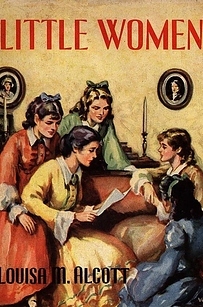 Jo March in the novel Little Women--Like Jo, I grew up in a financially challenged home. Jo works outside the home to help support her family. I worked at any job I could get—babysitter, tennis instructor, car hop, waitress, store clerk. Jo and I are both strong and determined; although I am better at controlling anger than she is. She spends some time in New York City. I worked there for twelve years during my thirties and forties. Jo is a writer. I am, too. It wasn't my profession, but I wish it had been.
Jo March in the novel Little Women--Like Jo, I grew up in a financially challenged home. Jo works outside the home to help support her family. I worked at any job I could get—babysitter, tennis instructor, car hop, waitress, store clerk. Jo and I are both strong and determined; although I am better at controlling anger than she is. She spends some time in New York City. I worked there for twelve years during my thirties and forties. Jo is a writer. I am, too. It wasn't my profession, but I wish it had been.
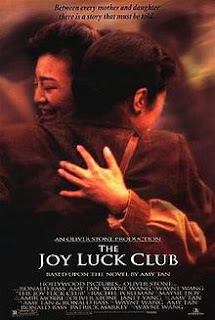 Jing-mei Woo (June) in The Joy Luck Club—I remember identifying with June throughout the novel, notably when her mother praises her for never taking the best quality crab. I try to respect the needs and wants of others which includes bypassing crab claws for body meat, or taking the smallest piece of cake on the plate. Like June, I was pushed to excel (at school rather than piano). My mother and Suyuan Woo were both critical mothers. Mine was especially critical when it came to socially acceptable behavior and physical appearance. I came to realize this wasn’t because she was mean, but because she wanted the best for me and my sisters. I know she loved me, and I loved her with all my heart.
Jing-mei Woo (June) in The Joy Luck Club—I remember identifying with June throughout the novel, notably when her mother praises her for never taking the best quality crab. I try to respect the needs and wants of others which includes bypassing crab claws for body meat, or taking the smallest piece of cake on the plate. Like June, I was pushed to excel (at school rather than piano). My mother and Suyuan Woo were both critical mothers. Mine was especially critical when it came to socially acceptable behavior and physical appearance. I came to realize this wasn’t because she was mean, but because she wanted the best for me and my sisters. I know she loved me, and I loved her with all my heart.
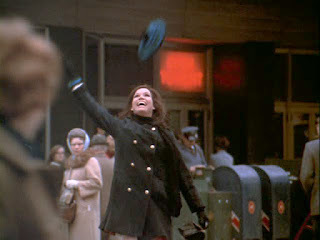 Mary Richards in “The Mary Tyler Moore Show”--A single woman who, at age 30, moves to Minneapolis after being jilted by her boyfriend of two years. I, a divorced woman of 30, moved to New York City after being cheated on by my husband of seven years. Mary ends up with a career in TV; whereas I worked in the apparel and cosmetics fields. Mary becomes friends with her next door neighbor in the boarding house she lives in. I became friends with one of my roommates in the New York apartment I rented. We are still friends to this day.
Mary Richards in “The Mary Tyler Moore Show”--A single woman who, at age 30, moves to Minneapolis after being jilted by her boyfriend of two years. I, a divorced woman of 30, moved to New York City after being cheated on by my husband of seven years. Mary ends up with a career in TV; whereas I worked in the apparel and cosmetics fields. Mary becomes friends with her next door neighbor in the boarding house she lives in. I became friends with one of my roommates in the New York apartment I rented. We are still friends to this day.

Anna from the movie “Frozen”--Although I am the oldest of three sisters rather than the younger of two, Anna is as devoted to her sister Elsa as I am to my sisters Karen and Susan. I am also optimistic and caring like she is and have her never-give-up attitude. I, too, was separated from my sisters for a long time, not because we had grown apart, but because I lived across the country for many years. Now we spend as much time together as we can.
 Jo March in the novel Little Women--Like Jo, I grew up in a financially challenged home. Jo works outside the home to help support her family. I worked at any job I could get—babysitter, tennis instructor, car hop, waitress, store clerk. Jo and I are both strong and determined; although I am better at controlling anger than she is. She spends some time in New York City. I worked there for twelve years during my thirties and forties. Jo is a writer. I am, too. It wasn't my profession, but I wish it had been.
Jo March in the novel Little Women--Like Jo, I grew up in a financially challenged home. Jo works outside the home to help support her family. I worked at any job I could get—babysitter, tennis instructor, car hop, waitress, store clerk. Jo and I are both strong and determined; although I am better at controlling anger than she is. She spends some time in New York City. I worked there for twelve years during my thirties and forties. Jo is a writer. I am, too. It wasn't my profession, but I wish it had been.  Jing-mei Woo (June) in The Joy Luck Club—I remember identifying with June throughout the novel, notably when her mother praises her for never taking the best quality crab. I try to respect the needs and wants of others which includes bypassing crab claws for body meat, or taking the smallest piece of cake on the plate. Like June, I was pushed to excel (at school rather than piano). My mother and Suyuan Woo were both critical mothers. Mine was especially critical when it came to socially acceptable behavior and physical appearance. I came to realize this wasn’t because she was mean, but because she wanted the best for me and my sisters. I know she loved me, and I loved her with all my heart.
Jing-mei Woo (June) in The Joy Luck Club—I remember identifying with June throughout the novel, notably when her mother praises her for never taking the best quality crab. I try to respect the needs and wants of others which includes bypassing crab claws for body meat, or taking the smallest piece of cake on the plate. Like June, I was pushed to excel (at school rather than piano). My mother and Suyuan Woo were both critical mothers. Mine was especially critical when it came to socially acceptable behavior and physical appearance. I came to realize this wasn’t because she was mean, but because she wanted the best for me and my sisters. I know she loved me, and I loved her with all my heart. Mary Richards in “The Mary Tyler Moore Show”--A single woman who, at age 30, moves to Minneapolis after being jilted by her boyfriend of two years. I, a divorced woman of 30, moved to New York City after being cheated on by my husband of seven years. Mary ends up with a career in TV; whereas I worked in the apparel and cosmetics fields. Mary becomes friends with her next door neighbor in the boarding house she lives in. I became friends with one of my roommates in the New York apartment I rented. We are still friends to this day.
Mary Richards in “The Mary Tyler Moore Show”--A single woman who, at age 30, moves to Minneapolis after being jilted by her boyfriend of two years. I, a divorced woman of 30, moved to New York City after being cheated on by my husband of seven years. Mary ends up with a career in TV; whereas I worked in the apparel and cosmetics fields. Mary becomes friends with her next door neighbor in the boarding house she lives in. I became friends with one of my roommates in the New York apartment I rented. We are still friends to this day.
Anna from the movie “Frozen”--Although I am the oldest of three sisters rather than the younger of two, Anna is as devoted to her sister Elsa as I am to my sisters Karen and Susan. I am also optimistic and caring like she is and have her never-give-up attitude. I, too, was separated from my sisters for a long time, not because we had grown apart, but because I lived across the country for many years. Now we spend as much time together as we can.
Published on October 08, 2016 09:54
September 7, 2016
Nature Writing
I enjoy coming up with ways to describe a sunset, weeds, animals, or dirt using a combination of words I haven't seen before. That can be hard to do without reverting to "purple prose," which makes good nature writing a challenge.
When I write a novel or short story, nature plays an important part in the setting. I may struggle with the plot or a relationship my characters are having, but I usually relax when I get to a place where I can interject a description of clouds, animals, water, trees, etc.
This summer I was asked to write a chapter on flora and fauna for a coffee table book on the history of Lake of the Woods, Oregon to be published next year. Below is one of the paragraphs I wrote for it.
The lake itself supports a variety of waterfowl. Some nest here. Others make it a stopping point during migration. From the campgrounds, resort, or lakeshore you can watch an osprey, similar in size yet whiter than an eagle, fold its wings, dive into the water feet first, and come up with a fish. Also seen on or near the water are great blue herons, Canada geese, grebes, buffleheads, and sandhill cranes. Occasionally a flock of American white pelicans will land on the lake. How delightful it is to watch these snowy birds with huge beaks and nine-foot wing spans soar through the air with the grace of birds half their size!
In 2011 I won a prize for a nature essay on tumbleweeds. Here is an excerpt.
Upwind from the road, a lone tumbleweed about the size of a bear cub bounded across the scant vegetation and over the crest of a gentle rise where it paused for a few seconds before leaping into the air and bouncing across the road. Strong-limbed, and with a few seeds left to sow, the tumbleweed rolled up the ditch bank into the waiting arms of a cluster of weeds with similar heritage, weeds stacked three feet deep against a barbed wire fence that shadowed the road as far as the eye could see. The thick pile of weeds made for a soft landing, but the thorny arms therein refused to let go, and the hapless tumbleweed’s gypsy days were over.
The story in my novel Brute Heart takes place in several natural settings. Most are in eastern Oregon. The one below describes a forest west of the Cascades.
The thick tangle of evergreen and deciduous trees embraced every imaginable shade of green, from the green-black undersides of the fir boughs to the chartreuse velvet moss that wrapped around the tree trunks and clung to the tops of rocks in the streambed. Vine maples, with sleeves of new green foliage, stretched across the rapidly moving water, their arms so long they sometimes entwined with limbs from the opposite side of the stream to form a leafy canopy.
More nature writing is included in a novel to be released (I hope) this year. The story takes place in Colorado.
The plip, plip, plip of melting icicles signaled the beginning of what amounted to spring in Ophir Loop. A misty rain, hard to distinguish from low clouds, hovered over the gorge once or twice a week. Snow was still being measured in feet above the timberline, but bursts of wild green dusted the slopes. The creeks had begun gurgling again, and the pussy willows growing along their banks were silver with catkins.
Every once in a while something on Facebook resonates with me, and I save it for future use. How appropriate this one is for a post on nature writing!
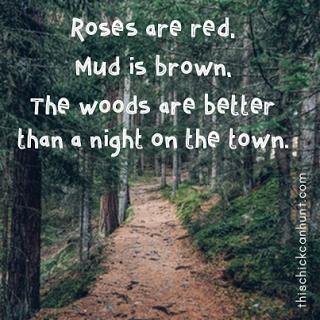
When I write a novel or short story, nature plays an important part in the setting. I may struggle with the plot or a relationship my characters are having, but I usually relax when I get to a place where I can interject a description of clouds, animals, water, trees, etc.
This summer I was asked to write a chapter on flora and fauna for a coffee table book on the history of Lake of the Woods, Oregon to be published next year. Below is one of the paragraphs I wrote for it.
The lake itself supports a variety of waterfowl. Some nest here. Others make it a stopping point during migration. From the campgrounds, resort, or lakeshore you can watch an osprey, similar in size yet whiter than an eagle, fold its wings, dive into the water feet first, and come up with a fish. Also seen on or near the water are great blue herons, Canada geese, grebes, buffleheads, and sandhill cranes. Occasionally a flock of American white pelicans will land on the lake. How delightful it is to watch these snowy birds with huge beaks and nine-foot wing spans soar through the air with the grace of birds half their size!
In 2011 I won a prize for a nature essay on tumbleweeds. Here is an excerpt.
Upwind from the road, a lone tumbleweed about the size of a bear cub bounded across the scant vegetation and over the crest of a gentle rise where it paused for a few seconds before leaping into the air and bouncing across the road. Strong-limbed, and with a few seeds left to sow, the tumbleweed rolled up the ditch bank into the waiting arms of a cluster of weeds with similar heritage, weeds stacked three feet deep against a barbed wire fence that shadowed the road as far as the eye could see. The thick pile of weeds made for a soft landing, but the thorny arms therein refused to let go, and the hapless tumbleweed’s gypsy days were over.
The story in my novel Brute Heart takes place in several natural settings. Most are in eastern Oregon. The one below describes a forest west of the Cascades.
The thick tangle of evergreen and deciduous trees embraced every imaginable shade of green, from the green-black undersides of the fir boughs to the chartreuse velvet moss that wrapped around the tree trunks and clung to the tops of rocks in the streambed. Vine maples, with sleeves of new green foliage, stretched across the rapidly moving water, their arms so long they sometimes entwined with limbs from the opposite side of the stream to form a leafy canopy.
More nature writing is included in a novel to be released (I hope) this year. The story takes place in Colorado.
The plip, plip, plip of melting icicles signaled the beginning of what amounted to spring in Ophir Loop. A misty rain, hard to distinguish from low clouds, hovered over the gorge once or twice a week. Snow was still being measured in feet above the timberline, but bursts of wild green dusted the slopes. The creeks had begun gurgling again, and the pussy willows growing along their banks were silver with catkins.
Every once in a while something on Facebook resonates with me, and I save it for future use. How appropriate this one is for a post on nature writing!

Published on September 07, 2016 10:36
August 8, 2016
Missing Mom
I have been without a mother for six months now. Yesterday, August 7, would have been her 100th birthday, and in lieu of the birthday card I sent her for decades, I wrote this poem.
August 7, 2016
You left six months ago.
I think about you when I
look in the mirror,
put on your pink earrings,
use your measuring spoons, or
wear the jacket you asked me to keep.
I planted a tree in your memory
(more twig than tree)
and named it Elsie.
Frozen, baked, and hailed on,
it has six new leaves.
I named it well.
Sometimes I sense your presence
in the enigmatic eyes of my cat,
or while walking along the canal
where you used to walk,
or when the topmost branch of a juniper
waves though there isn't a hint of breeze.
Today is your one hundredth birthday, Mom.
Are there birthday parties in Heaven?
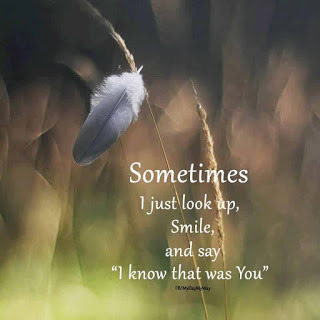
August 7, 2016
You left six months ago.
I think about you when I
look in the mirror,
put on your pink earrings,
use your measuring spoons, or
wear the jacket you asked me to keep.
I planted a tree in your memory
(more twig than tree)
and named it Elsie.
Frozen, baked, and hailed on,
it has six new leaves.
I named it well.
Sometimes I sense your presence
in the enigmatic eyes of my cat,
or while walking along the canal
where you used to walk,
or when the topmost branch of a juniper
waves though there isn't a hint of breeze.
Today is your one hundredth birthday, Mom.
Are there birthday parties in Heaven?

Published on August 08, 2016 16:01
July 18, 2016
Irish Inspiration
My husband and I spent ten days touring Ireland earlier this month. We covered much of the larger half of the country, but did not make it to Belfast. I came back to Oregon with a better understanding of how the country’s natural beauty coupled with its history inspired many of its authors and poets.
I have always been amazed at how such a small country could produce so many noted writers: George Bernard Shaw, William Butler Yeats, James Joyce, Samuel Beckett, and Sean O’Casey, for example. After motoring through the gorgeous green countryside and learning about the hardships the Irish people have endured over the centuries, the inspiration to wax poetic (Yeats) or write ironic prose (Jonathan Swift) became obvious.
Rebellions and revolutions shape much of the Irish psyche. We toured Kilmainham Prison in Dublin where many involved in the 1916 Easter Rising were housed before being executed in the prison’s yard. Built in 1796, the prison’s cold, dark walls seemed to echo the misery of the prisoners housed in its bleak cells. We also visited Glasnevin Cemetery where Michael Collins, revered leader of the struggle for Irish independence, is buried. The 1996 movie, Michael Collins, starring Liam Leeson was one of the options offered by Aer Lingus on the flight over and back. Dick and I both watched it, giving us additional insight into the turmoil that took place in Ireland during the early twentieth century. There was brutality on both the British and Irish sides of that conflict.
It’s the civilians that suffer, when there’s an ambush they don’t know where to run. Shot in the back to save the British Empire. Shot in the breast to save the soul of Ireland. I believe in the freedom of Ireland and that England has no right to be here, but I draw the line when I hear the gunmen blowing about dying for the people when it’s the people that are dying for the gunmen. Sean O’CaseyThe Irish people had to work hard, eking out a living on stony glacial moraines. For centuries few owned the land they worked, and when the potato famine hit in the 1840’s, it was the poor farmers who starved. Those who were able to flee crowded onto small ships headed for America. We toured a replica of one of those boats and viewed the cramped steerage where over one hundred emigrants were packed. With a 20% date rate common during Atlantic crossings, the boats came to be called “coffin ships.”
“Faeries, come take me out of this dull world,
For I would ride with you upon the wind
Run on the top of the disheveled tide,
And dance upon the mountains like a flame.”
W.B. Yeats
On the brighter side, the countryside is green and gorgeous, peppered with sheep and small, well-tended farms. Flowers and trees thrive in the rainy climate, and every farm seems to have a garden. The whole of it creates a picture perfect landscape. “The best place to find God is in a garden. You can dig for him there.” George Bernard Shaw
Our tour guide asked us to write limericks since the city of Limerick was part of our tour. Mine went like this: “We gathered from far and wide
In Ireland to abide.
We learned about Guinness,
And soon it was in us
For a rollikin’, cracky ride.”
Ginger Dehlinger
What tripe compared to the Irish writers, but fun. J
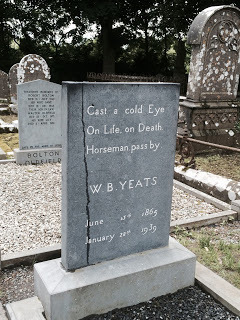
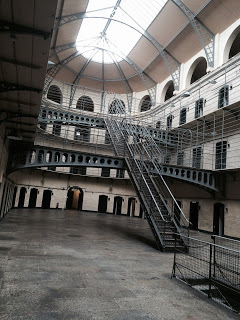 Kilmainham Prison
Kilmainham Prison
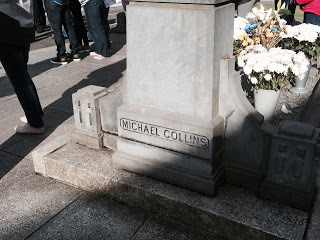
I have always been amazed at how such a small country could produce so many noted writers: George Bernard Shaw, William Butler Yeats, James Joyce, Samuel Beckett, and Sean O’Casey, for example. After motoring through the gorgeous green countryside and learning about the hardships the Irish people have endured over the centuries, the inspiration to wax poetic (Yeats) or write ironic prose (Jonathan Swift) became obvious.
Rebellions and revolutions shape much of the Irish psyche. We toured Kilmainham Prison in Dublin where many involved in the 1916 Easter Rising were housed before being executed in the prison’s yard. Built in 1796, the prison’s cold, dark walls seemed to echo the misery of the prisoners housed in its bleak cells. We also visited Glasnevin Cemetery where Michael Collins, revered leader of the struggle for Irish independence, is buried. The 1996 movie, Michael Collins, starring Liam Leeson was one of the options offered by Aer Lingus on the flight over and back. Dick and I both watched it, giving us additional insight into the turmoil that took place in Ireland during the early twentieth century. There was brutality on both the British and Irish sides of that conflict.
It’s the civilians that suffer, when there’s an ambush they don’t know where to run. Shot in the back to save the British Empire. Shot in the breast to save the soul of Ireland. I believe in the freedom of Ireland and that England has no right to be here, but I draw the line when I hear the gunmen blowing about dying for the people when it’s the people that are dying for the gunmen. Sean O’CaseyThe Irish people had to work hard, eking out a living on stony glacial moraines. For centuries few owned the land they worked, and when the potato famine hit in the 1840’s, it was the poor farmers who starved. Those who were able to flee crowded onto small ships headed for America. We toured a replica of one of those boats and viewed the cramped steerage where over one hundred emigrants were packed. With a 20% date rate common during Atlantic crossings, the boats came to be called “coffin ships.”
“Faeries, come take me out of this dull world,
For I would ride with you upon the wind
Run on the top of the disheveled tide,
And dance upon the mountains like a flame.”
W.B. Yeats
On the brighter side, the countryside is green and gorgeous, peppered with sheep and small, well-tended farms. Flowers and trees thrive in the rainy climate, and every farm seems to have a garden. The whole of it creates a picture perfect landscape. “The best place to find God is in a garden. You can dig for him there.” George Bernard Shaw
Our tour guide asked us to write limericks since the city of Limerick was part of our tour. Mine went like this: “We gathered from far and wide
In Ireland to abide.
We learned about Guinness,
And soon it was in us
For a rollikin’, cracky ride.”
Ginger Dehlinger
What tripe compared to the Irish writers, but fun. J

 Kilmainham Prison
Kilmainham Prison
Published on July 18, 2016 11:13
June 14, 2016
Out-takes
During my last critique group meeting, one of my fellow writers had written a beautiful paragraph that some of us thought wasn’t right for the piece he submitted. I told him to save what he had written. That it might work better in a future story.
This prompted a lively discussion of “out-takes,” some members of our group saying they simply deleted unwanted copy, others saying they kept a file of temporarily unusable verbiage but rarely referred to it.I keep an out-take file for every major piece I am writing, and I do check them from time to time, especially when I experience a serious case of writer’s block. On a few occasions I found exactly what I needed. Many times I wasn’t able to use what I had saved, but reading what I had written stimulated my brain, leading me to write something that did fit. Other times I left empty-handed.
We writers often fall in love with what we write and don’t want to let it fall victim to the delete key. I have been guilty of wasting precious time, trying to find a place for something I thought was “brilliant.” J My out-take files allow me to save these little gems, writing which I may read later and ask myself, “What was I thinking?”My advice is don't force feed your writing. You probably will change a lot of things before you are finished, and trying to work your story around a favorite paragraph or two can kill your progress.
This prompted a lively discussion of “out-takes,” some members of our group saying they simply deleted unwanted copy, others saying they kept a file of temporarily unusable verbiage but rarely referred to it.I keep an out-take file for every major piece I am writing, and I do check them from time to time, especially when I experience a serious case of writer’s block. On a few occasions I found exactly what I needed. Many times I wasn’t able to use what I had saved, but reading what I had written stimulated my brain, leading me to write something that did fit. Other times I left empty-handed.
We writers often fall in love with what we write and don’t want to let it fall victim to the delete key. I have been guilty of wasting precious time, trying to find a place for something I thought was “brilliant.” J My out-take files allow me to save these little gems, writing which I may read later and ask myself, “What was I thinking?”My advice is don't force feed your writing. You probably will change a lot of things before you are finished, and trying to work your story around a favorite paragraph or two can kill your progress.
Published on June 14, 2016 10:03
May 15, 2016
A Motherless Mother's Day
The Friday before Mother's Day I was standing in line at my favorite supermarket, surrounded by reminders of what was being celebrated Sunday. A huge display of potted plants--orchids, mini roses, African violets, and some I couldn't name--was off to my right. On my left, a store employee was dipping strawberries in white or dark chocolate, covering them with candy sprinkles, and then carefully inserting the elegant treats into clear plastic clamshells.
In front and in back of me, every shopping cart displayed some sign of motherly affection. One cart held a fluffy pink teddy bear, and every person shopping either had a card in their hand or one in their basket.
I watched a woman debating over which plant to buy for her mother. She was turning each one over to read the price on the bottom. Finally she picked a small, green, non-flowering plant, and I wanted to tell her to put it back and take the pretty one. "You are lucky to have a mother," I wanted to say. "Spoil her as long as you can."
My own mother died in February, and I am still getting over it. Below is a poem I wrote about our weekly phone conversations, and wouldn't you just know it?--Mother's Day always falls on a Sunday.
Sunday Mornings It’s Sunday.
I make waffles,do a little writing,take my daily two-mile walk,wash a load of clothes.
Every Sunday morningfor thirty-six yearsI called my motherat ten o’clock.We talked for an hour or more.
“What’s that noise?”she would ask.“I can hear you doing something.”“I know, Mom,” I’d say to heras I unloaded the dishwasher.
Every Sunday morningI used to hurry through my work,marking things off my list,hoping to finish by ten.I never made it.
Sometimes Mom heard carspassing by while I walked and talked.“I’m on my walk,” I’d explain.“I’m taking you with me.”“Good,” she’d say. “I need the exercise.”
Now every Sunday morning,I chalk off my chores until ten. Then there’s a hole in my day,and an ache in my heart,because she’s gone.
Ginger DehlingerMarch 2016
In front and in back of me, every shopping cart displayed some sign of motherly affection. One cart held a fluffy pink teddy bear, and every person shopping either had a card in their hand or one in their basket.
I watched a woman debating over which plant to buy for her mother. She was turning each one over to read the price on the bottom. Finally she picked a small, green, non-flowering plant, and I wanted to tell her to put it back and take the pretty one. "You are lucky to have a mother," I wanted to say. "Spoil her as long as you can."
My own mother died in February, and I am still getting over it. Below is a poem I wrote about our weekly phone conversations, and wouldn't you just know it?--Mother's Day always falls on a Sunday.
Sunday Mornings It’s Sunday.
I make waffles,do a little writing,take my daily two-mile walk,wash a load of clothes.
Every Sunday morningfor thirty-six yearsI called my motherat ten o’clock.We talked for an hour or more.
“What’s that noise?”she would ask.“I can hear you doing something.”“I know, Mom,” I’d say to heras I unloaded the dishwasher.
Every Sunday morningI used to hurry through my work,marking things off my list,hoping to finish by ten.I never made it.
Sometimes Mom heard carspassing by while I walked and talked.“I’m on my walk,” I’d explain.“I’m taking you with me.”“Good,” she’d say. “I need the exercise.”
Now every Sunday morning,I chalk off my chores until ten. Then there’s a hole in my day,and an ache in my heart,because she’s gone.
Ginger DehlingerMarch 2016
Published on May 15, 2016 08:38



